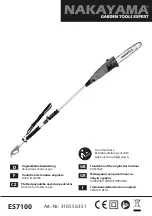
38
TROUBLE SHOOTING
Repair and adjustment procedures should
be made only by experienced maintenance
personnel, or by a DoAll service representative.
Reference to the machine's electrical and
hydraulic schematics will be helpful.
MACHINE WILL NOT START
1.
Check that both disconnect switches are in the “ON”
position.
2. The
All Stop
pushbutton needs to be reset (rotate
the button head
clockwise
).
3.
See if the main fuses and/or circuit breakers have
tripped or burned out.
4.
Make sure both bandwheel doors are closed.
5.
Push the motor starter overload reset buttons in
the electrical cabinet. If overload tripping occurs,
locate and correct the problem.
6.
Check the control transformer for power.
7.
Check the hydraulic motor and wiring.
8.
Check the starter, relay coils and contacts for faulty
operation.
9.
Have an electrical service person check the continuity
of the starting circuit.
MACHINE STARTS, BUT WON’T CONTINUE
RUNNING
1.
The saw band is broken or too long and is activating
the band break proximity switch
(1 PRS
or
1 LS).
2.
Check to see if the bandwheel doors are closed (the
band drive motor will not start unless both doors are
closed).
3.
The saw head has not cleared the head down
promimity switch
(2 PRS
or
2 LS)
. Move the
Saw
Head Control
selector to “UP”.
4.
The out of stock limit switch
(6 PRS
or
6 LS)
has
been actuated.
SAW BAND STALLS DURING A CUT
1.
Decrease saw head feeding pressure.
2.
Check to see if drive belt tension is adequate to
resist "cogging" underload.
3.
Use a Tensigage to check for proper saw band
tension.
4.
Check for proper operation of the
Band Tension
selector.
BLADE TOOTH GULLETS ARE LOADING
1.
Use a coarser pitch saw band.
2.
Increase the band speed setting, or decrease the
feed pressure setting.
3.
Check for improper coolant application.
4.
Check the positioning of the band brush. Replace
the brush, if necessary.
SAW BAND SQUEAL
1.
The lead-in/exit rollers are:
(a)
Not contacting the
saw band; or
(b)
Positioned too tightly against the
saw band.
2.
Check for defective lead-in/exit roller bearings.
SAW BAND VIBRATION
1.
Check for a dull or damaged saw band.
2.
Incorrect band speed or feed pressure setting is
being used.
3.
Check for incorrect saw band pitch.
4.
Coolant mixture is weak, or incorrect coolant is being
used.
5.
Stockpiece is not being firmly clamped by the vise
jaws.
6.
Check for worn or improperly-adjusted saw guide
inserts.
7.
Check for a worn saw guide back-up bearing or
lead-in/exit roller bearing.
8.
Check for incorrect saw band tension.
PREMATURE BLADE TEETH DULLING
1.
Band speed and/or cutting rate is too high.
Summary of Contents for C-4100NC
Page 1: ...C 4100NC Serial No 524 97116 to 524 11322 524 13338 to Band Sawing Machine Instruction Manual ...
Page 5: ...1 MACHINE DIMENSIONS FOOT PAD LAYOUT ...
Page 6: ...2 MACHINE DIMENSIONS Continued INCHES 03 MILLIMETERS 1 mm FLOOR PLAN 5 Foot Index Option ...
Page 7: ...3 MACHINE DIMENSIONS Continued INCHES 03 MILLIMETERS 1 mm FRONT VIEW ...
Page 9: ...5 MACHINE FEATURES TOP VIEW FRONT VIEW ...
Page 35: ...31 LUBRICATION NEXT 2 PAGES ...
Page 37: ...33 LUBRICATION DIAGRAM FRONT VIEW SIDE VIEW REAR VIEW LEFT SIDE ...








































